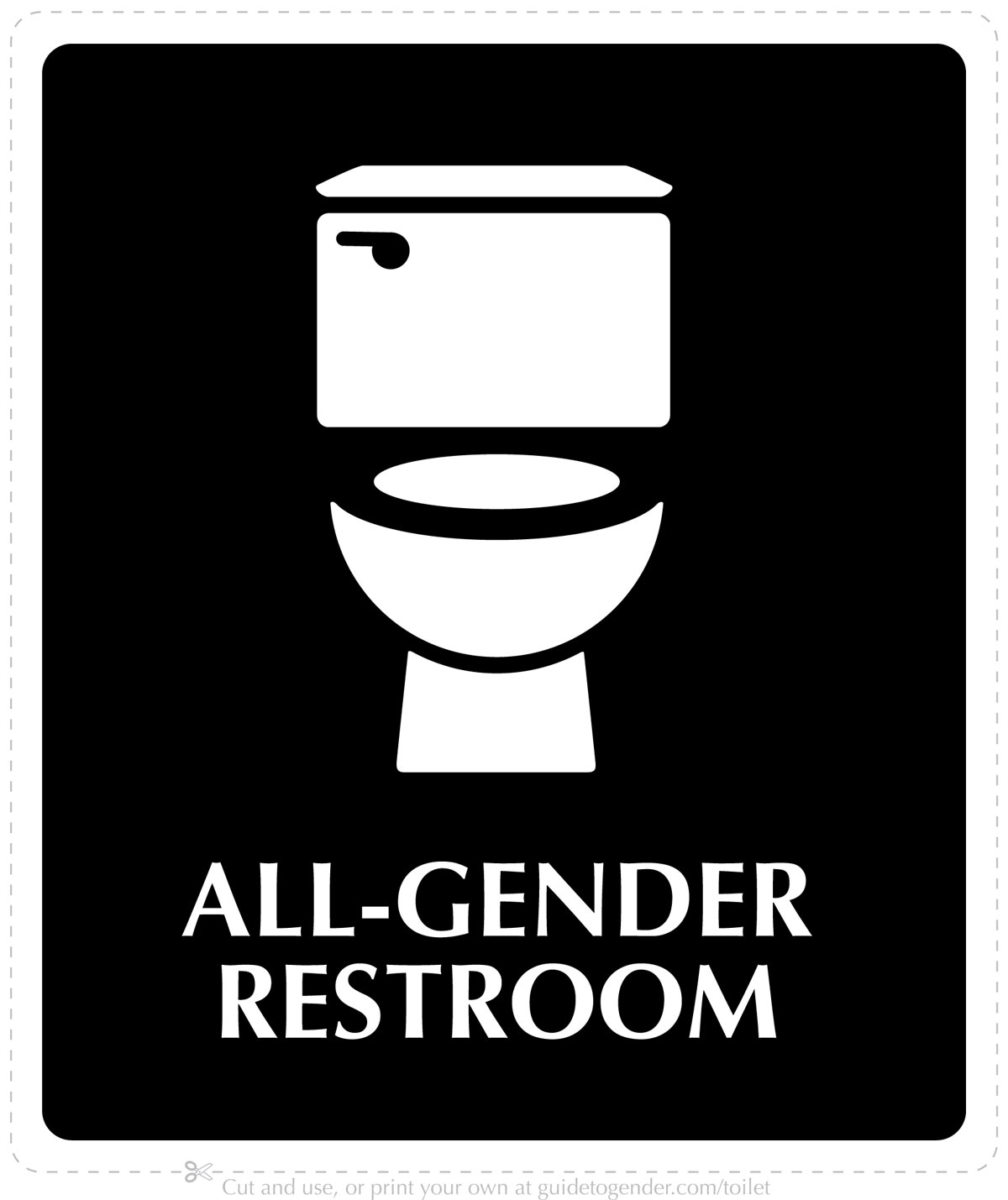In the winter of 2013, I was bouncing around North America attending town halls. I was invited by local activists, trans* folks, and advocacy groups who wanted me to hear about or weigh in on a discussion that was taking center stage in their communities. The issue being discussed: bathrooms. And, more specifically, who gets to pee where.
Two sides took hold: one side said that everyone (cisgender and transgender people alike) should have a right to use the restroom that makes sense for them; the other side said everyone should use the restroom that matches the sex they were assigned at birth, regardless of their gender identity or expression.
A few years later, in the U.S. and elsewhere, a national discussion similar to the ones I experienced in little town hall meetings erupted. The two sides became further entrenched, and each found its own rallying cries, statistics, and boilerplate arguments. We’ll call the first side, the one advocating for people to use restrooms that correspond with their identity, “Pro Restroom Equity.” And we’ll call the other side “Against Restroom Equity.”
Now, I suppose it goes without saying which one of these camps I find myself in. But if you’re somehow left in suspense, I’ll keep you there for just a bit while I lay out some of the common arguments made against restroom equity.
Arguments Against Restroom Equity
The majority of what I heard back in 2013 is still echoing around today, and can be neatly grouped into 3 primary categories: safety, tradition, and logistics.
“If we let people use whatever restroom they identify with, it will be dangerous.”
The first thing to clarify in the safety arguments is whose safety folks making these arguments are concerned about: generally, the safety of cisgender women and girls. While the argument may not be posed exactly as above, or explicitly state “women and girls,” this is the implication.
The concern is that “sexual predators” (and other “deviants,” or people labeled with deviant-sounding descriptors) will see an equitable bathroom policy as an opening to attack women and girls. And the implication made by this argument is that anyone unmoved by it, or who argues against it, doesn’t care about safety or avoiding public dangers.
“Bathrooms have always been this way, and it’s been fine. Changing that is a slippery slope.”
The tradition arguments, whether they are connected directly to restrooms and public facilities, or to sensibilities about gender more broadly, are generally built on two premises: one, that things have always been this way; and two, that changing it up would be bad.
As an example, one might argue that we have always had men’s and women’s public restrooms, they’ve always been separated that way, and it’s worked out well so changing it would be inviting unnecessary risk.
Occasionally, an element of “social experiment” is added to these arguments (e.g., “We shouldn’t let this liberal conspiracy into our bathrooms”). This argument, for me, evokes the image of a mad scientist whose method of wreaking havoc is slightly altering bathroom policies.
“How would this even work? What would we put on the door?”
The logistics arguments are what I initially heard the most, specifically from people who were likely harboring the above sentiments, but were reluctant to speak on them. These would often be progressive-leaning politicians, or townspeople who didn’t want to “stir the pot,” but still wanted to make their objections known.
These arguments range from the superficial (e.g., focusing on signage) to the hyperbolic (“If transgender people get to use their restroom do we need to build more restrooms? Do we need to rebuild all of our public buildings?”1), but the key differentiator from the above arguments is that these intentionally avoid values statements either for or against affirming trans* people. Or they’re made with exception to some values statement (e.g., “I’m not against transgender people, but what do you put on the door?”).
Arguments For Restroom Equity
Responding to the themes above, there are about a million different rabbit holes we might find ourselves navigating. But let’s keep it simple. How might one make a case for restroom equity, only by rebutting the arguments above? By not rebutting at all, but championing those same three sentiments.
Restroom equity IS a safety issue.
Let’s talk about the problem we’re trying to solve by preventing restroom equity: transgender people entering restrooms to harass or assault cisgender people (women and girls). In 2015, the year this argument really started to explode in the United States, how many of these cases were reported?
None.
Literally zero. Now, that’s not to say that it’s never happened, nor that it won’t ever happen. It’s just to say that there doesn’t appear to be a big risk (or any risk) imposed by transgender people in public restrooms.
So how is this a safety issue?
Well, the 2015 United States Transgender Survey found that about 9% of trans* people had been denied access to a restroom, in public restrooms 12% had been verbally harassed, 1% sexually assaulted, and 1% physically assaulted. Further, over half of those surveyed had said they’d avoided using public restrooms (out of fear of confrontation, or other problems), resulting in 32% limiting the food and water they consume, and 8% developing kidney problems or urinary tract infections.
So it’s great that so many people are concerned about safety, because reforming the current policy, policing, and norms of restrooms are necessary to achieve safe public spaces.
Evolving policies about public restrooms IS a longstanding tradition.
Our current conversation about restrooms is a reprisal of one that’s happened several times throughout history. You don’t even have to go back very far to see how much this has changed, and how flexible we are as a society.
Speaking about the U.S., we didn’t have laws segregating restrooms by gender until the late 19th century. Until 1954, it was legal to segregate a restroom by race. And it wasn’t until 1990 that we had laws to prevent restroom discrimination against people using wheelchairs (and folks with other disabilities affecting restroom access).
The conversation about restroom equity is one we’ve had so many times, and revised our public opinion, laws, and norms on so many times, you might say that changing the ways we think about restrooms is our tradition.
We’ve done this lots of times, and we were not only okay, but better as a result. In fact, when we look back on the restroom policies of the pre-90s, pre-50s, and pre-1890s, they all seem backwards and overtly discriminatory. Because they were.
And, if you want to get really traditional, we used to not have public restrooms at all: the public was our restroom. Those were the days.
And restroom equity makes FOR the easiest logistics.
Let’s consider two laws: one that says people use the restroom with which they identify, and the other that says we are only to use a restroom that corresponds to the gender marker on our birth certificate.
For the second law, suppose we notice someone we suspect to be entering the wrong restroom. How might we enforce this?
Ask them to see their birth certificate? Is this before or after they pee? Must we all carry our birth certificates around at all times? Also, who is the one checking the birth certificates? Must we hire bathroom deputies? How much will that cost? What if people create fake birth certificates? How will we verify authenticity? Ooo! One of those little blue lights like at bars? Oh no, but what about the lines?
For the first law, suppose we notice someone we suspect to be entering the wrong restroom. How do we enforce the law: we go about our day. End of enforcement.
If this sounds ridiculous, or like I’m manufacturing an absurdity and arguing against that, I can assure you of two things: yes, it’s ridiculous, and no I didn’t make it up. North Carolina did, with their now-infamous HB2 “Bathroom Bill.”
And it’s not just North Carolina. Many other U.S. States and municipalities have introduced similar legislation through 2015, 2016, and beyond. Texas, the state that I live in, and from which I am writing this chapter, introduced a bill on January 5, 2017 that says much the same, and more.
Moving toward restrooms for folks of all genders
Now, suspend your disbelief, but I’m going to come out and say it: I’m in favor of restroom equity.
We should allow transgender people to pee in peace because it’s the safest policy, most traditional approach to this issue, and offers the simplest logistics.
By simply not making exclusionary laws, a chunk of this controversy is settled. As I described above, cisgender people are not at risk of being attacked by trans* people in restrooms. So we don’t have to make new laws to protect cisgender people 2. Great!
But that won’t solve the entire problem.
In following our tradition of restrooms being at the center of civil rights, it’s important for us to consider what laws we already have that are exclusionary, and in ways that don’t benefit the public good.
For example, every restroom that is single occupancy could easily be an all-gender restroom. That change is as simple as changing the sign on the door.
But when it comes to shared restrooms, there are laws in place (in the U.S. and elsewhere) that set strict building standards related to men’s and women’s restrooms. These laws exclude folks who don’t fit within that binary, and those who identify with a third gender. So changing them, and finding workarounds in the meantime, will be necessary to achieve restroom equity on the gender front.
As for signage, the “What do we put on the door?” argument, you are, in your hands, holding a sign you can use. The back cover of this book features a design I created after those town halls, and published on my site in a fit of frustration and snark. Much to my surprise, it is now being produced and implemented on several continents. I invite you to cut it out (or print it, available through this book’s website), attach it to a restroom door, and create your own all-gender restroom.
That’s how easy this can be. This whole problem doesn’t have to be a problem, and there’s a good chance we’ll look back on it the same way we look back on past restroom controversies: with a sense of shame mixed with a matter-of-fact “how ridiculous we used to discriminate like that.”
Or at least I hope that’s the case.
1 That’s an actual statement, from a well-intentioned city councilperson in a small midwestern US town, who will remain unnamed.
2 If a bunch of cisgender people report being assaulted or harassed by trans* people, that will be a bummer. But there is an already-existing-before-this-hypothetical-situation silver lining: that behavior is already illegal, and can be enforced. That is, we already have laws that make assault and harassment, sexual and otherwise, illegal.


